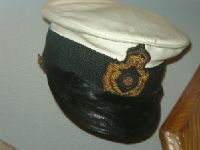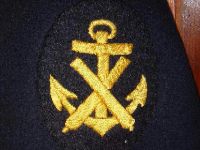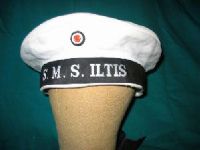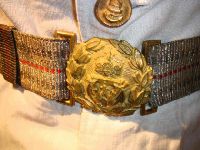|
Figure 1 is based on a photograph
of a Naval Officer of the Tsingtao garrison taken during captivity in
Japan. He wears a white summer officer's peaked cap, with black hatband and a
small black/silver/red cockade surrounded by a gold wreath and imperial crown on
the front (see right). A similar cap was also issued in dark blue.
He wears a double breasted blue winter officer's
jacket with his rank displayed by gold bars surmounted by an imperial crown on
his cuffs. In common naval officer's fashion he wear wears a high neck white
shirt and thin black tie under the jacket and blue naval trousers. |

German Naval Officer's Cap
(See
Naval Uniforms Details Page)
IWM Collection |
|
Figure 2 is based on a
photograph of a NCO of the Kiaochou Naval Batteries taken just after the fall of Tsingtao.
He wears a blue winter naval cap with an Imperial cockade and a
black tally with "5. MATROSENARTILLERIE KIAUTSCHOU 5." (or other
corresponding battery number) in gold across the
front with the ties trailing down at the back (see below left), a blue winter other ranks double breasted jacket with blue collar patches
bearing one gold bar to signify his rank and his specialist status is displayed by
gold insignia on his upper left arm (see right). He wears blue winter naval trousers tucked
into jackboots. He carries his kit and possessions in a naval rucksack ("Seesack")
on his back, these were often decorated with unit insignia (again see the
Naval Uniforms Details Page for
examples). As a prisoner of war he has been stripped of weapons and
ammunition but many of the land based naval units would have been armed with the Mauser 98 rifle and
would have carried M1908 ammunition pouches on their belts.
|

Specialist Insignia of a Naval Gunner
(See
Naval Uniforms Details Page)
Photo Copyright Doppler |
|
Figure 3 is based on a
photograph of Matrose Christian Vogelfänger from "SMS Jaguar" taken during captivity in Japan
in regulation uniform.
He wears a blue winter naval cap with a small black/white/red cockade and a
black hat band with "SMS JAGUAR" in gold across the front with the
ties trailing down at the back (see below centre), a white summer naval top with light blue collar
scarf (although the colour did vary from light to dark blue- see right) with three white
edging stripes, tied at the front with a black neck tie with white
cord. He also wears blue winter naval trousers. This mixture of summer and
winter uniform items was not uncommon.
Matrose Christian
Vogelfänger (1896-1980) from Düsseldorf, served on the SMS
Jaguar during the siege of Tsingtao. He was taken Prisoner of War and kept at
the Tokyo-Asakusa and Narashino camps in Japan where he had a dog named Strolch
and wrote a diary, some of which can be read at the
Tsingtau Info website.
In the 1960's he was still a member of the Tsingtao Comrades Group (Tsingtau-Kameradschaft).
Figure 4 is based on a
photograph of a NCO of the Naval Batteries taken just after the fall of Tsingtao.
He wears a blue winter naval cap (see white summer example below left) and uniform.
His rank is displayed by a gold chevron on his upper left arm. On the white
summer uniform this chevron would have been in dark blue.
|

Back of the sailor's collar
(See
Naval Uniforms Details Page)
Photo Copyright Doppler |
|
|

A White Summer Naval Cap from the SMS
Iltis
(See Port Arthur Collection Page)
Photo Copyright Private Collector |
Figure 5 is based on a posed
pre-war photograph of Leutnant zur See Gunther Plüschow, the German Naval Pilot in
Tsingtao during the 1914 siege. His flying helmet is non-regulation and along with the goggles may
have been personal additions. He wears a leather flying jacket similar to those
worn by pilots and drivers in the regular army of the time, although
this one may possibly be privately purchased. The jacket has naval officer's
rank insignia added to the cuffs (in this case the imperial crown
above a single gold bar indicating a Leutnant). The jacket is tied at the waist with
a regulation Naval Officer's belt in silver braid with red and black stripes and
gold buckle (see
right). His
trousers appear from the cut to be riding breeches in navy blue. He also wears
leather gaiters above his ankle boots. This was typical of naval officers
ashore. He caries a leather satchel for his charts and observation notes.
Leutnant zur See Gunther Plüschow (1886-1931), nick-named the "Dragon
Pilot" due to a tattoo of a dragon on his left arm, was the only
German airman on active duty based in Tsingtao in 1914. During the
siege he ran spotting missions in a Rumpler Taube over the Japanese and British fleets and was
unofficially credited with the first aerial "kill" of the war. When the garrison surrendered and
went into captivity he escaped and made his way back to Germany via China,
Japan, America and Gibraltar where he was briefly captured by the British and taken to
England, only to escape once more and make his way back to Germany via Holland.
On his return he was ironically arrested as a spy at first, but was eventually
recognised and awarded the Iron
Cross First Class. He was the only German prisoner to escape from a British mainland
POW camp during either World War. He also wrote several books including one on his experiences in China and his
journey back to Germany called "Escape from England" (see
Book Reviews page). After the war he explored
uncharted areas of Chile and Patagonia where he died in a flying
accident in 1931. |

A Naval Officers belt buckle
(See
Seebataillon White Uniform Page)
Photo Copyright Doppler |